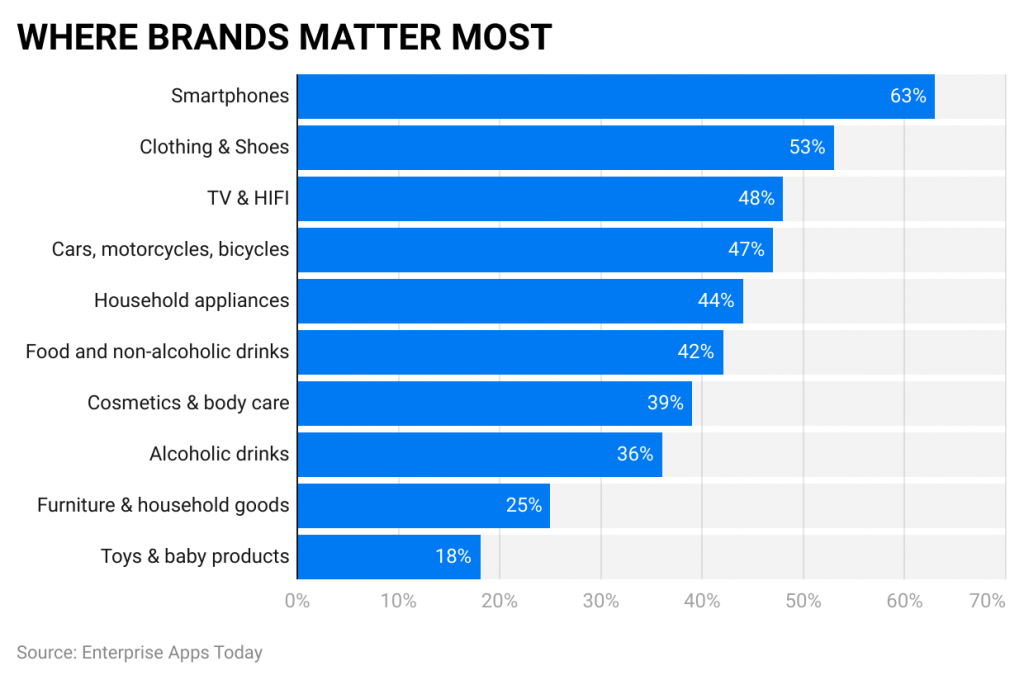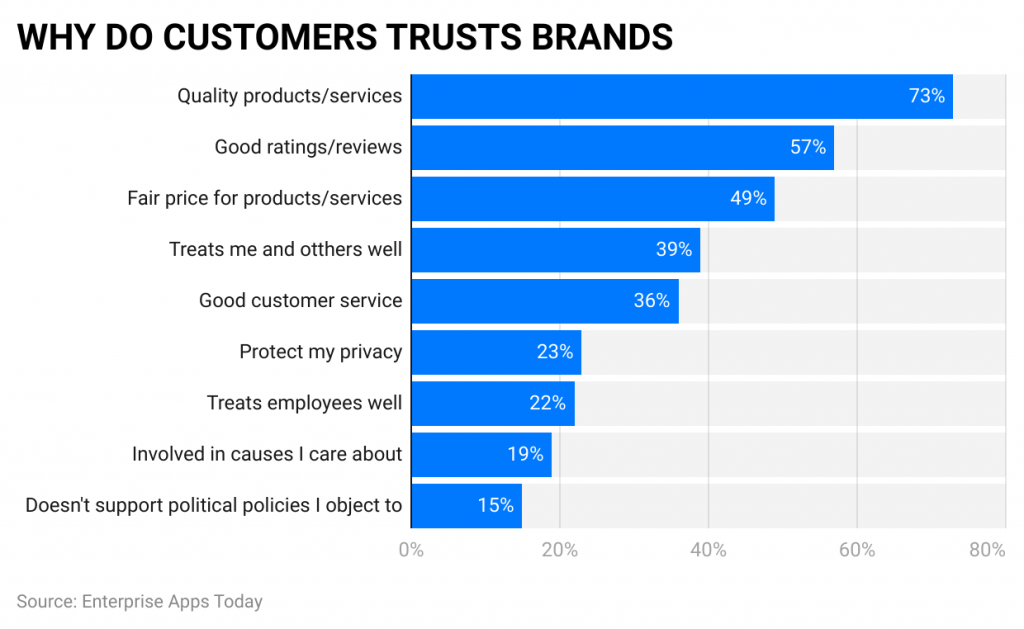90+ Branding Statistics, Fact, Trends For Good Impression

Page Contents
Introduction
Branding Statistics: Branding is the most important process in a company’s lifetime. Branding helps to understand the value of a product or service using the company’s logo, vision, and goals in the eyes of the customers. To be honest, branding is a crucial process to perform as the world is leaping into a hyper-competitive environment. There is n number of companies performing on the same level with similar products. Out of this, a company has to show why it is different from everyone else. These branding statistics will give an insight into how people believe in the branding of the company.
These statistics prove that a company without a brand is nothing and people prefer only those companies whose brands have a higher image. In these branding statistics, the importance is also mentioned to increase the awareness of the branding strategies. In the initial days of the company, branding can be difficult to build, but once customers start believing in the company and the company stays transparent then the business will never experience any setbacks
Key Branding Statistics (Editor’s Choice)
- In reality, only 48% of employees working in companies with branding have faith in their own brands
- Brand value is generally increased using company websites, marketing, advertising, and social media networks which contribute 21%, 12%, and 47% respectively
- Companies with less effective branding over the other competitors are generally found to be paying higher salaries
- When a company has an enormous brand image, candidates with a 90% success rate accept the job offers.
- Around 33% of the companies have blue color in their brand logo e.g., Visa, Facebook, Twitter
- Shades of color also decide the brand value by 80%
- Companies need to make 5 to 7 impressions in the eyes of the customer before they form the shape of a brand.
- Companies that have a presence of their brand on all kinds of platforms such as online and offline have the ability to increase their revenue by 23%
- Branding statistics say that other content such as blogs, articles, etc. plays an important role as the content is generated by users and can impact other customers just by reading it. Users can impact other users’ decisions on purchasing habits resulting in 79%
- More than 200 million brands are believed to be using Facebook’s free marketing tools
Importance of Branding
In the world of competition, without branding, no company will experience any success. Branding needs to be done at the initial stage of the company, once the market knows the value the customers are automatically going to come and buy the same product maintaining the level of retention. Following are some important notes on branding.
- The crucial importance above all is maintaining the level of the image in the eyes of the customers. Branding has the ability to differentiate the products and services offered by the company from its competitors.
- Branding can be communicated through logos, visions, different shapes of fonts, and many other graphical features. Rather than conducting lengthy seminars and showing how the company is different, these tiny graphical things can convey big messages.
- Branding helps to differentiate the value from others on national and international levels.
- Branding can be the company’s tangible asset.
- Branding authorizes the business and outlines its purpose.
- A message of branding can also be given from infographics and visuals.
Categories Where Branding is Most Important
 (Source: zippia.com)
(Source: zippia.com)
The top three product categories where Branding is the most important are Smartphones (63%), Clothing, and Shoes (53%), and TV and WiFi (48%). For products related to toys, furniture, and household or baby products, branding takes little importance compared to its usability and quality.
Top Reasons to Trust a Brand
 (Source: zippia.com)
(Source: zippia.com)
The top reason to trust a brand is the quality of the products and services offered by the company. Furthermore, consumers also believe in reviews and ratings given by other customers. Thus, to have a strong branding in the market, the above factors must be considered to last longer.
General Brand Statistics
- 64% of the people decide to purchase the product or service offered by the company after referring to the brand videos on social media networking.
- 34% of the business that runs on a small scale generally invest in video branding.
- Most small-scale industries provide branding through social media networks resulting in 73%.
- Brands with regular blogging have experienced an increase in leads by 67%.
- In reality, only 48% of employees working in companies with branding have faith in their own brands.
- 94% of the customers prefer those brands which are connected with emotions.
- When companies open-mindedly share their brand values retention is increased to 89%.
- Brands affected by political reasons have divided around 62% of the customers in the market
- Companies with loyal brands attract 43% more customers than their competitors
- Around 70% of brand managers believe in creating value by brands and increasing the customer database rather than converting leads into sales
- Brand value is generally increased using company websites, marketing, advertising, and social media networks which contribute 21%, 12%, and 47% respectively
- 77% of brand managers believe in branding in terms of company growth.
- Branding has helped 55% of companies to attract future employees.
- Considering the social media networks, hashtags used on Instagram, which are branded resulted in 7 out of 10.
- Companies with less effective branding over the other competitors are generally found to be paying 10% more salaries.
- Branded companies that have negative remarks are affected by incoming candidates by up to 21%
- When a company has an enormous brand image, candidates with a 90% success rate accept the job offers.
- Brand increases 70% of value in the eyes of the customer while content marketing
- Content under a brand has more effects on the minds of the customers by 80%
- Around 53% of businesses irrespective of their company size, use content marketing in brand strategies
- Brands with unique products increase the attraction of customers by 61%.
- 54% of the customers prefer information from branded companies.
- Continuous branding over the markets increases awareness by 23%.
- Studies show that when people feel emotions created by music added to the video by the brands increases the favorability by 46% towards the company.
- Around 80% of the audience will get attracted to those brands that have eye-catchy colors in videos, logos, and such graphical things
- Studies show that customers need only 10 seconds to judge the company by its logo.
- Around 33% of the companies have a blue color in their brand logo e.g., Visa, Facebook, and Twitter.
- Shades of color also decide the brand value by 80%.
- 82% of the customers believe in the name of the brand more than the logo.
- Around 77% of consumers purchase the product with reference to brand names rather than focusing on the product itself.
- If a company has an excellent brand name, it has the ability to cut down the costs occurring during hiring and training by 50%
- Lesser than 10% of the B2B companies state that they have consistency in managing the brand image
- In terms of social media, and excellent brand image, candidates also consider the presence of top-level management on social media networks before applying for a position in the company
- Around 68% of the men and 64% of the women feel close to the brand and becomes the deciding factor before purchasing the product
- Around 86% of the audience on social media prefer honesty and authenticity in the brands present on social media networking sites
- In the United States of America, 4 out of 10 customers discontinued the purchase habit from their regular brands because the company failed to provide trust. On the same note, 31% of the customers believe that trust can build better brands.
- According to studies in recent years, it has shown that 94% of customers are loyal to their brands when transparency is provided by the company. As well as the rate of retention is also increased.
- Customers prefer consistency, quality, cost, and experience from the brands as a method of retention
- 72% of the brands have unique names
- A high level of branding helps customers to choose a gift from the same brand during the occasions resulting in 44%
- 62% of the companies believe in online brand visibility
- Mothers who like posts of big brands are normally influenced by other mothers in the world resulting in 38%
- 59% of the people repeat the action of purchasing from the same brands. On the other hand, 21% of the customers prefer to try new brands for a change
- In the global market, 73% of the customers go behind those brands that offer customization as well as personalization
- Customer who prefers eco-friendly products will prefer brands that make a positive impact around the world resulting in a 50% increase in purchasing power accounting for 13% of the customer.
- Companies need to make 5 to 7 impressions in the eyes of the customer before they form the shape of a brand.
- 73% of the customers prefer those brands that have excellent after-sales customer service
- Companies with only one star in the brand review if preferred only by 21% of the candidates
- In the current times, 69% of employers are building their own branding strategies in collaboration with the marketing department
- Around 63% of techno-savvy people always focus on the brand of the mobile phones before purchasing it
- Around 94% of the people in the world recognize the logo of the Coca-Cola brand
- Companies that have the presence of their brand on all kinds of platforms such as online and offline have the ability to increase revenue by 23%
- Brand image is based on the first impressions
- 64% of the customer want their favorite brands to speak up about social issues
- Branding statistics say that other content such as blogs, articles, etc., plays an important role as the content is generated by users and can impact other customers just by reading it. Users can impact other users’ decisions on purchasing habits resulting in 79%
- 95% of the top brands prefer to use only two colors in the brand logo.
- According to Fortune 500 companies, 60% of businesses use a combination of logos to create 1 logo for their brand
- Description brand logos have more effects on the minds of the customer than a simple logo
- Around the world, 40% of companies use description logos whereas 60% goes to nondescriptive logos
- Customers who have emotional attachments to the brands they love increase their value it by 306 times
- Content marketing around branding can increase the rate of leads by 3 times
- Email marketing helps 40 times faster than any other promotional activities while branding the company
- Branding statistics also state that when a brand has greater customer service 86% of the people get positively affected.
- 78% of the marketers believed that positive content marketing can increase the brand image of the company
- Around the world, 85% of the companies follow their own brand guideline whereas, 30% of the companies have less effective branding strategies
- Automation in the branding process can increase its effectiveness
- 69% of the customers usually get in touch with brands that have chatbots
- Branding content has increased its importance over the years
- Around 50% of people experience multiple brands in their lifetime with the same or different category
- Influencer marketing increases the branding process by 34%. Whereas, frequent website visits, short videos, experiential marketing, and virtual events can increase the brand by 33%, 31%, 29%, and 31% respectively
- In the process of increasing brand awareness, if the process is overdone it loses its image in the eyes of the customers.
- Referrals increase the brand image resulting in a 78%
- In the United States of America, for companies with top brands, customer check their affiliate website before making a decision on the purchase
- More than 200 million brands are believed to be using Facebook’s free marketing tools
- Companies do rebranding in around 7 to 10 year
Conclusion
These branding statistics prove how branding is important in today’s world. There are many big brands around the world in every category and they are performing very well just because they have gained enough brand image. Most people prefer branded products because they offer quality and transparency over any local products. Moreover, branding can help companies gain access to international markets while being a local business company.
Technology is increasing healthy competition around the world. Therefore, to stand out from competitors branding is the most important step after launching the business. Well, it is not only that branding is performed in the initial days only but, the brand image shall be continuously preserved in the minds of the customer to increase the life of a company. There are many conceptions of how people look at brands just by judging them by the shape and color of the logo. Therefore, branding plays the most important role above all processes of the company.
FAQ.
Establishing identity, Performance management, judgment, and brand resonance are the 4 most crucial steps in the branding process.
As a part of the process of brand establishment, and amid competitors, branding is somewhat difficult and needs perfection to catch the attention of the customers.
Depending on the various aspects, the branding process could last up to 4 to 6 weeks.

Barry is a lover of everything technology. Figuring out how the software works and creating content to shed more light on the value it offers users is his favorite pastime. When not evaluating apps or programs, he's busy trying out new healthy recipes, doing yoga, meditating, or taking nature walks with his little one.